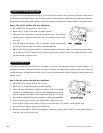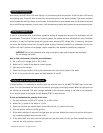
© 2006 Directed Electronics—all rights reserved 7
The antenna position should be discussed with the vehicle’s owner prior to installation, since the antenna may
be visible to the vehicle’s operator. The best location for the antenna is centered high on either the front or rear
windshield. For optimal range, the antenna should be mounted vertically. It can be mounted horizontally in rela-
tion to the windshield or under the dashboard away from metal, but range will be diminished. Metallic window
tint can also affect range, so this should be a consideration when determining the mounting location.
After determining the best mounting location, follow these steps:
1. Clean the mounting area with a quality glass cleaner or alcohol to remove any dirt or residue.
3. Mount the antenna using the supplied double-sided tape.
4. Route the antenna cable to the control module and plug it into the antenna connector.
IMPORTANT! To achieve the best possible range, DO NOT leave the antenna cable bundled under
the dash. Always extend the cable full length during installation, regardless of the antenna mount-
ing location.
Some things to remember about where to mount the shock sensor:
■ Never put the Stinger
®
in the engine compartment!
■ Find a spot close to the control module so that the wires do not need to be extended. Keep it away from the
heater core (or any other heat sources) and any obvious leaks.
How the Stinger
®
is mounted is the most important factor in its performance. We recommend two methods:
■ Using double-sided tape or hook-and-loop fastener to mount to a trim panel or an air duct,
or
■ Wire-tying to a wire harness.
If mounting the sensor where it cannot be easily reached for adjustment, hook-and-loop fastening tape (such as
Velcro) is recommended for ease of removal for future adjustments.
NOTE: In many vehicles, tying the sensor to a steering column or screwing it to metal will result in
poor sensitivity, especially at the rear of the vehicle.
locations for stinger doubleguard shock sensor
mounting the antenna


















